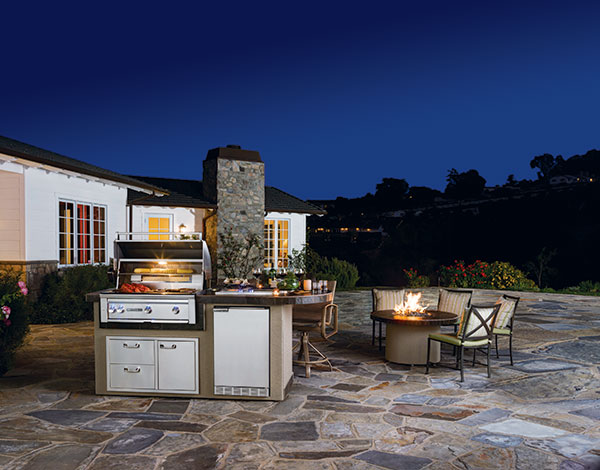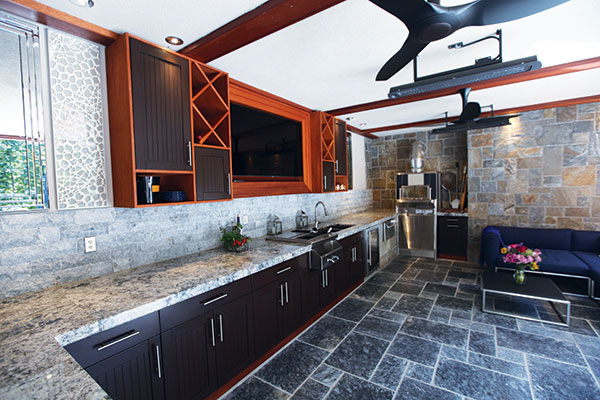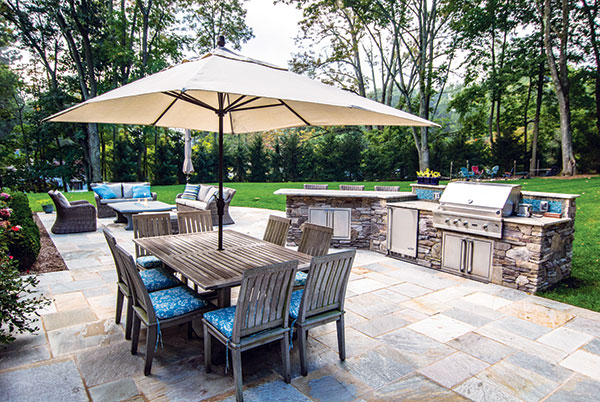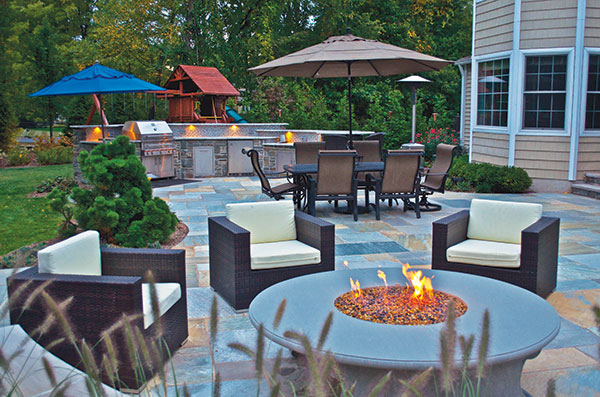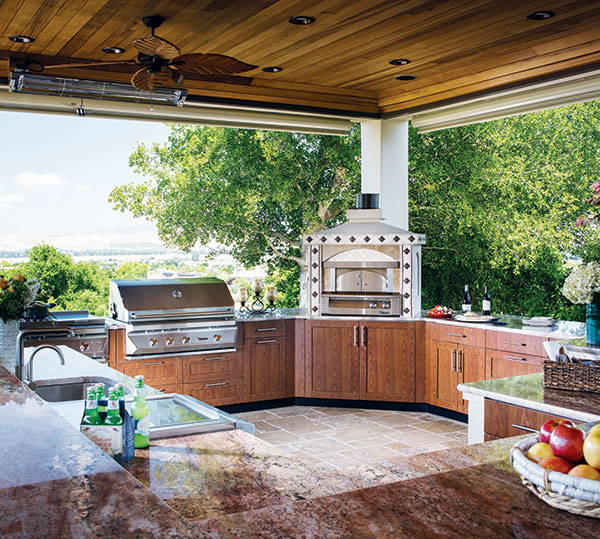Guidelines for a Great Outdoor Kitchen
Writer Mary VinnedgeCheck all nine of these boxes to be sure your space is ideal for prep, cooking and serving.
The outdoor kitchen is born when the grill cozies up to cabinetry, countertops and indoor-style appliances—with refrigeration a must, says Michael Belforti of Better Housekeeping Shop in Red Bank. Until then, it’s just a grill on a patio or deck. But what makes an outdoor kitchen a fully functioning space? Belforti, Tom Bain of Bain’s Outdoor Living in Rumson and Chris Cipriano of Cipriano Landscape Design and Custom Swimming Pools in Mahwah, both located in New Jersey, contributed to the following checklist.
Workspace
Allot adequate counter space for prep (chopping, mixing, seasoning) and landing zones for finished foods. Lowes.com says to allow 36 inches on either side of the grill and burners, and 18 to 24 inches of open space on both sides of sinks.
Choose countertops that are easy to wipe and hose down. Marble, quartz composites, granite and concrete are options. For granite, Cipriano prefers a leather finish because a shiny finish shows dust, and
flamed granite looks dull. Concrete countertops are surging in popularity, he says. “You can do any finish:―old wood, planks, inlays, stenciling,” he says. “The design options are phenomenal.”
Grills
Almost always powered by natural gas, the grill is the keystone of the outdoor kitchen so be sure it’s large enough. Think beyond the number of people you entertain; consider your cooking style too. Do you grill meat and veggies simultaneously? Then upsize, Cipriano says, recommending that a family of four have at least a 48-inch grill. Bain agrees: “Bigger is better.” And Belforti points out that offset-style cooking, without the flames directly under the meat (often used for rack of lamb, chicken and ribs), requires more grill surface.
All three experts say side burners stretch your cooking capacity—sauté your vegetables instead of grilling them, boil a huge pot of Jersey sweet corn, etc. Burners also are perfect for messy tasks you don’t want to do indoors, such as blackening fish with smoke billowing, Belforti says.
Accessories to consider: a superhot searing station, smoker and/or rotisserie.
Other Appliances
Every appliance available indoors is also available outdoors in special safety-rated models, Belforti says. Refrigeration, a prerequisite for outdoor kitchens, ranges from undercounter refrigerators to beer kegs and wine chillers to ice machines. Popular perks are:
• Pizza ovens. “They’re huge right now,” Belforti says. He recently installed a $20,000 model; countertop options can cost just $1,500. Some are dual-fuel—wood and natural gas. All are fully functioning ovens that can cook breads, casseroles and more as desired.
• Warming drawers.
• Dishwashers in 18- and 24-inch widths.
• A ventilation hood, with caveats. “If the outdoor kitchen has three walls, a vent is essential,” Belforti says. “If it doesn’t have three sides, it’s very hard for the hood to be effective because of crosswinds.”
Cabinetry
Cabinets—which must keep out rodents, spiders and other pests—are set into stone, stucco or brick masonry. Powder-coated finishes on stainless steel are available in many colors and wood looks. The brands include Alfresco, Brown Jordan Outdoor Kitchens, Danver Stainless Outdoor Kitchens, Lynx and Viking. Belforti, Bain and Cipriano advocate an in-cabinet trash compartment for convenience and cleanliness.
Lighting
Lampposts plus undercounter and overhead lighting maintain functionality after dark, and Cipriano says grills with built-in lighting also help the chef. Bain, who says his clients often hide lighting in pergolas, explains that “the lighting is not what you would read a book by. It’s lighting for entertaining.”
Sink
Add a sink if possible, Belforti advises. It will minimize trips to the house. Some sinks run off outdoor faucets.
Roofs
A cover can provide a haven from rain and scorching sun. Bain says about 80 percent of his clients with pergolas also purchase a retractable canopy. “Their dermatologists love it,” he says, “and a summer rain won’t ruin a dinner party.” He recommends Shade FX, available in an array of durable Sunbrella fabrics.
Nice to Have
• Supplemental heating: Fire pits and portable metal heaters stretch the months of use.
• Ceiling fans. “They add a nice downward breeze if you have the overhead clearance,” Bain says.
• Mosquito control: Add a mister that goes off at certain times of day to deter these pests. Portable and plumbed-in units are available, Bain says.
• Hot water: It can be supplied from the pool house or main house or a small unit in the outdoor kitchen.
Expert Help
Bain says homeowners should involve various trades to obtain the best of everyone’s specialties: landscape architects, hardscape experts and outdoor kitchen designers. And he emphasizes communication: “Customer interaction is very important. For the best results, the professionals need to find out where their customers’ inspiration is coming from.”
Seating Strategies
Lowes.com says:
• Allocate 36 to 42 inches of open space around the edges of the dining table so traffic flow is easy when chairs are in use.
• Eating counters need 24 inches of width per stool and 15 inches of legroom.
Limited Budget?
• Consider a prefabricated outdoor kitchen (Lynx is an option) for $6,500 to $9,000, says Michael Belforti of Better Housekeeping in Red Bank. These include a grill, storage drawers, refrigerator, seating area, wires for electrical outlets and even USB ports for mobile devices.
• Chris Cipriano of Cipriano Landscape Design and Custom Swimming Pools suggests using stone veneer that’s about 2 inches thick rather than the standard 4 inches. There’s no sacrifice in durability, he says.
Native Texan Mary Vinnedge and her husband often barbecue on their balcony, which has distant views of Galveston Bay and the Gulf of Mexico. You can email her through her website, WritingGenie.com.

